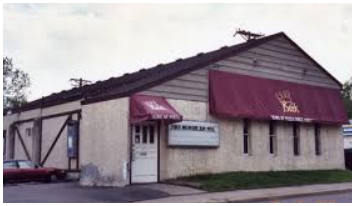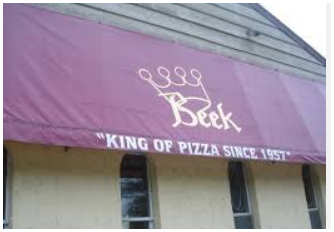Wonderful hot turkey sandwiches! Absolutely fabulous! Oh, how I miss the Lincoln Del! Pumpernickel rolls, matzoh ball soup, hot beef sandwiches, meatballs.
I have fond memories of the del, as obviously so many others do. Thanks, Wendy, for this book.Do a Kindle version of the cookbook!
Happy trip down memory lane. Thanks for the memories!
Among my best-loved restaurants of all time, anywhere. The cabbage borscht on a January night at -12 degrees was a little slice of heaven and a hour's sanctuary. For a French dip sandwich, I've never found its equal. I still miss the Del.
I went there as a youngster for Matzo ball chicken soup and rugalah (sp?) and kept going back often through my teens and early twenties for everything on the menu! I also remember seeing the tattoo on the arm of one of my waitresses - she was a holocaust survivor - I was humbled and in awe of her strength and perseverance.
I believe Jan and Cy Schoenwetter were the owners of the local franchise for Weight Watchers.We ate at the Lincoln Del (west) many times a week. I hope the book includes lots of pictures. I especially remember the framed clown paintings in the bar area. I would buy roasted turkey to go at the deli/bakery counter. It was actual roasted turkey breast--way better than the pressed meat available at grocery stores. I also loved the lemon rolls.Hoping the recipe for the French Dressing is in this book
It was indeed sad to see the Lincoln Del go slowly down hill, finally ending in a painful death.
I can still taste the French Dip, Beef Barley Soup and the Chocolate Pie. And don't forget the Kosher pickles.The place was always packed, with lots of activity and noise. Great memories. I worked at the Lincoln Del West during the last half of my senior year of high school until I left for Navy boot camp in November. It was the best place I ever worked. I even worked shifts when I came home on leave. The Berenbergs were so wonderful ! There is not a day goes by where I wish "the Del" was still around. I cannot think of any restaurant today that can match the food, the love and the atmosphere that 'The Del " had. I will be buying the book and enjoying the food but I will always miss the fun and the joy of working and eating there. Thank you Ms. Rosenstein, thank you !!!!!
In the late 70s/early 80s, as a group we'd always head over to the Del or La Terrace (in the old Hotel Sofitel) on 494, after closing down the restaurant/bars we worked at on the strip. Have a bite to eat during the late nite/early morning hours and unwind. Was always a great place to and run by such friendly, welcoming hosts. Both the Del and Terrace were all-night operations back then.
I miss that whole west end area and what it was - the Del, the Cooper, My Pie (the symbol). All gone.
Mmmmm, dill pickles on each table!
There is a place in Palm Springs called Manhattan in the Desert that comes very close to how good the Del was.
Chocolate pie from the Del was a birthday tradition for my best friend and myself, for many years. It was amazing.
i need the Potato Salad Recipe today!
Wow, a memory from the past. Enjoyed having some meals at the West Del with dates.
Reminds me of another great Deli just a block or two west on Lake St - Bernie's. Bernie was always there to great you. He would tell us "eat, eat, it's good for you!" Wonderful food and memories.
so many great meals at the Lincoln Del. Matzo Ball soup. Hermit cookies. scrambled eggs with matzo (hoppel popped). I remember my former boss taking me there for the first time and pointing out the old timers with WWII concentration camp tattoos on their forearms. They were Holocaust survivors. What a place. What a very special place. Don't forget the 9 layer Surgeon General Koop Cake!
Oh the Matzo Ball soup--it could not be matched. I hope the recipe is in the cookbook !
The best Reuben I've eaten ever! One of the waitress' told me they used Mayo on the bread, not 1000 island dressing. Is that true? And the best Florentine Cookies in the universe! Really great stuff and good memories.
***
BEEKS BEEKS BEEKS BEEKS BEEKS BEEKS
To all classmates: Following is the letter announcing Beeks closing:
Beeks Pizza has closed effective today-Monday, November 14, 2016 The Beeks property at 6325 Minnetonka Boulevard in St. Louis Park has been sold. The option to relocate Beeks Pizza is no longer being considered. This has been a difficult decision for our family, knowing Phil dedicated an entire lifetime of "blood sweat and tears" to build and prosper the Beeks business he dearly loved and enjoyed. Leaving behind an entity that has been an integral part of each of our lives is not easy; change is difficult. Blessed be our memories of Beeks and the beloved man who worked tirelessly to build his successful dream. In the end, my desire to pursue new and exciting professional opportunities, to begin a new chapter of my life with my loving and supportive fiancé, and my deep need and desire to ENJOY my beautiful children and be a part of their lives has trumped the satisfaction and pride that comes with owning a successful small business. My family joins me in sincerely thanking our Beeks customers for your patronage and incredible loyalty. To the Beeks staff-past and present- you are FAMILY, now and as I move forward. Each of you contributed to the amazing success of Beeks Pizza. My prayers for your personal success and happiness. Blessings to you all! My family and I thank you for choosing Beeks Pizza-"King of Pizza since 1957".Long live the King.
***
FROM THE BEEKS WEBSITE: WWW.BEEKSPIZZA.COM
Our Story
Old world flavour, hand made every single day


Beek's Pizza is named for Mr. Beekman, its original owner. Back in 1953, Beekman opened his first neighborhood pizza parlor on Hiawatha Avenue in Minneapolis. The place was small, cramped, and had a leaky roof. But it had atmosphere… and the pizza was great! Beek's Pizza became "the place": high-schoolers gathered on Friday nights, the guys brought their dates, and families came too.
Beek's secret? 'Old World' flavor that was fresh and homemade. The pizza dough was made daily from scratch. Sound good? The delicious, tangy pizza sauce, spaghetti sauce and meatballs were homemade too. Only the freshest meats and vegetables went into Beek's pizzas. There were no preservatives in the meats or cheeses; only the finest ingredients were approved, including imported spices. And they were all smothered in gooey mozzarella cheese.
That was over 50 years ago… and the tradition continues today. We still put it all together according to Beekman's original recipes. The recipes are committed to memory and relied upon every morning to make the dough, pizza sauce, meatballs, spaghetti sauce, and our NEW original chicken wing sauce. It is all homemade and "hand-made"; we even mix the "secret recipe" spices by hand! We demand the freshest ingredients and they remain free of preservatives. Every Beek's pizza is still topped off with real mozzarella! Beeks is also known for, remembered and sought out for our distinctive and delicious THIN CRUST! It's the only crust we offer and we think we have achieved perfection.
Hard to believe? Well, we "learned from the master," so to speak. And early every morning the Beek's kitchen is brought to life with the sound of the ol' Hobart mixer turning out its daily batch of hand-made dough amidst the smells of the simmering homemade sauces… still the secrets of Beek's 'Old World' taste!
We remain committed and proud to be independently owned and operated: no corporate parent company dictates our decisions or our future. Beek's Pizza is eager to serve you at 6325 Minnetonka Blvd. in St Louis Park, opened in 1957.
Our children have grown up in our pizza world and work along side of us today. Our staff IS our family… so you see, the business of pizza is something we take personally! The result? The finest pizza this side of '53. We have the most loyal customers and look forward to meeting you! We appreciate each and every order, whether we deliver it a block or you drive 30 miles or more to get your "Beeks fix." You are important to us. Please accept our sincere thanks for your loyalty and patronage.
No shortcuts… just the best. Enjoy!
With our thanks, Phil & Mari
Gallery





